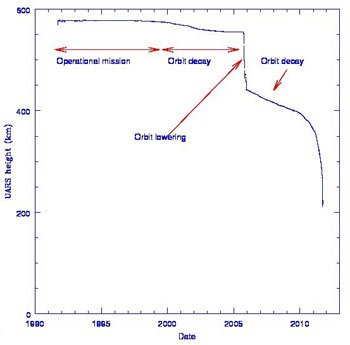[UPDATE: Alan Boyle at Cosmic Log is reporting that the satellite will definitely come down on Friday, though NASA is not sure yet exactly when and where.]
[UPDATE 2: Emily Lakdawalla at The Planetary Society blog has lots of detailed info now.]
 By now you’ve probably heard that NASA’s Upper Atmospheric Research Satellite (UARS, pronounced YOO-arz, though in my head it’s always “You arse!”) will burn up in our atmosphere some time between Thursday and Saturday. The satellite was decommissioned in 2005 and they used the remaining fuel to lower the orbit. It’s been slowly getting lower since then, but recently reached the part of our air where it slows and drops dramatically. As you can see from this plot (click to embiggen), it’s dropped from about 375 km to 200 in just the last few months, and down it’ll come later this week.
By now you’ve probably heard that NASA’s Upper Atmospheric Research Satellite (UARS, pronounced YOO-arz, though in my head it’s always “You arse!”) will burn up in our atmosphere some time between Thursday and Saturday. The satellite was decommissioned in 2005 and they used the remaining fuel to lower the orbit. It’s been slowly getting lower since then, but recently reached the part of our air where it slows and drops dramatically. As you can see from this plot (click to embiggen), it’s dropped from about 375 km to 200 in just the last few months, and down it’ll come later this week.
No one knows where or when it will hit, since the final flight path will depend on changing atmospheric conditions, orientation of the satellite, and so on. Most of the 6 ton satellite will burn up, but some two dozen or so pieces are expected to survive re-entry.
Speaking of which: I’m seeing some concern over people getting hit by this thing. The odds of that are extremely low. It’s possible – NASA rates the odds at about 1 in 3200 – but highly unlikely. Mind you, those are the odds of anyone getting hit by debris. The odds of a specific person, say me, getting hit are far lower – if I’m doing this math correctly, you’d multiply that number by the population of the Earth, nearly seven billion people. So the odds of me (or you, or pick someone) specifically getting hit are about 1 in 20 trillion. Pretty long odds.
In the meantime, on September, 15th, “amateur” astronomer Thierry Legault was able to capture video of the satellite while it passed over his location:
Cool, eh? You can see the rotation; it’s tumbling, apparently. Out of power, it can’t keep the correct attitude, and over time something has caused it to spin. Maybe it was a collision, or maybe it’s from other subtle but persistent forces over the years (solar wind, light pressure, drag through our tenuous upper atmosphere, slow fuel leak, what have you). Here are some stills from Thierry’s video to make that more clear:
Pretty cool. So stay tuned. I’ll update with more info when I get it; we’ll know the re-entry time and location much better as the week progresses. I’ll be tweeting about it as well as soon as I find anything out.
Credits: Orbit plot: Jonathan McDowell; UARS images: Thierry LeGault.
Related posts:
- YouTube video where I explain a satellite re-entry
- BREAKING: SpySat successfully hit by missile
- The return of Stardust
- Spy sat to come home… not too secretly